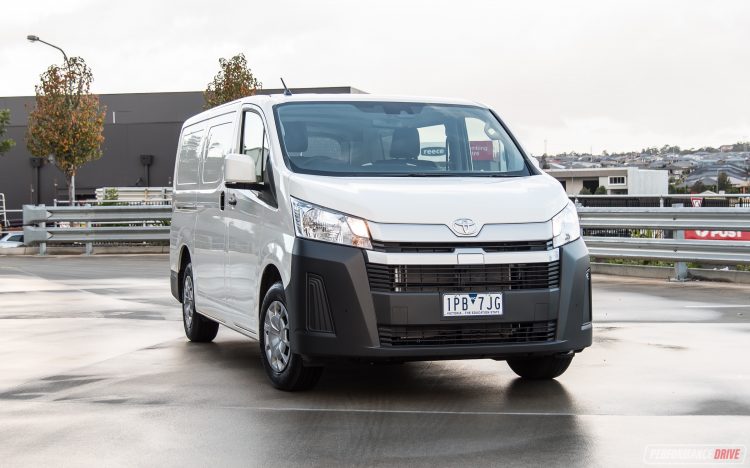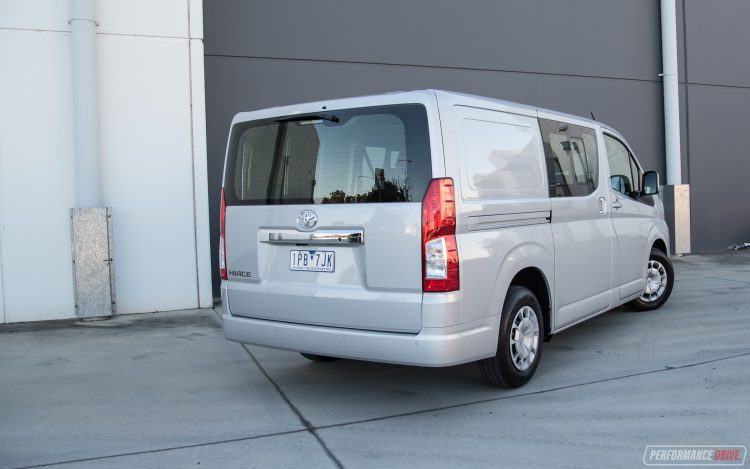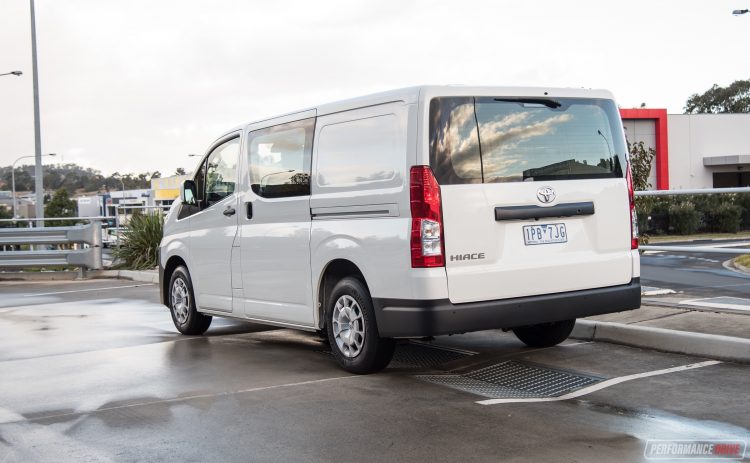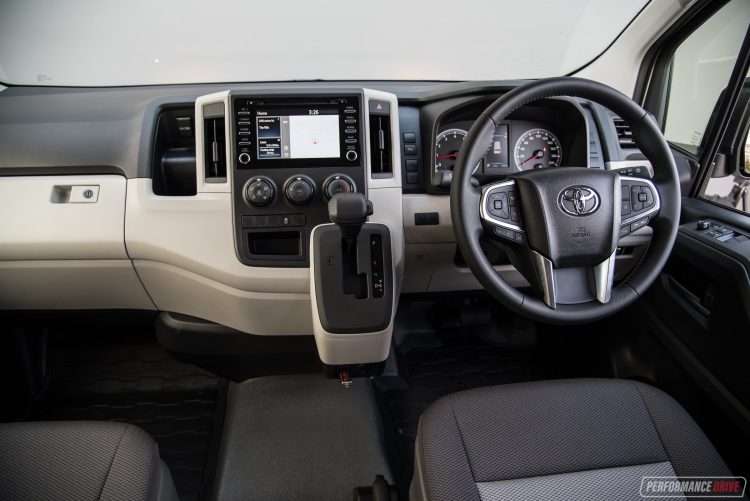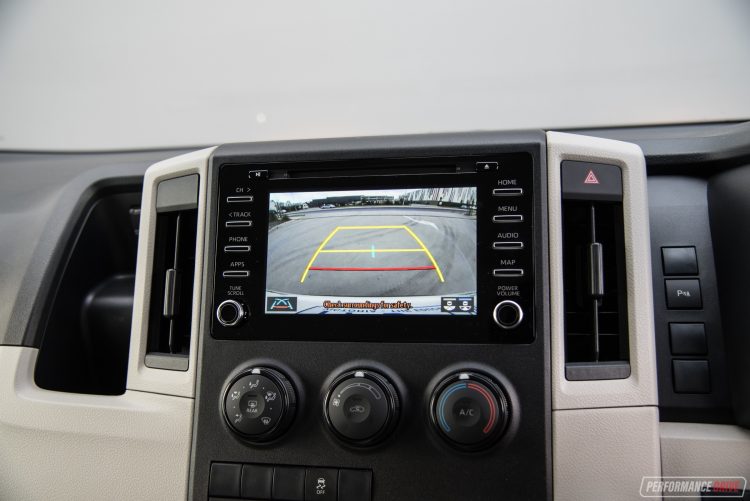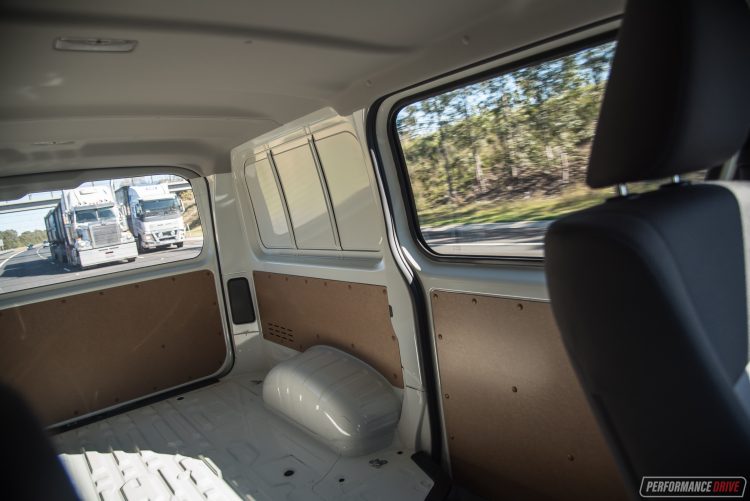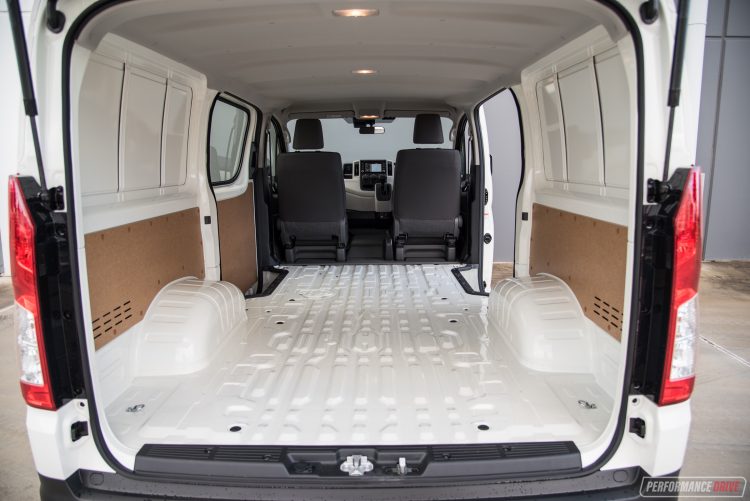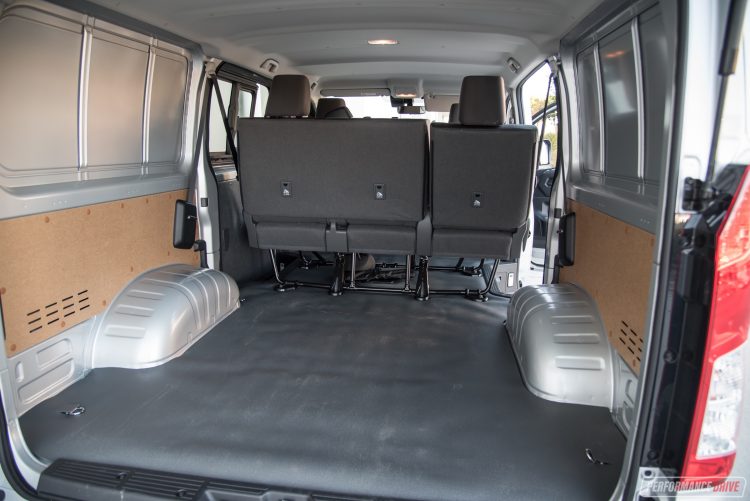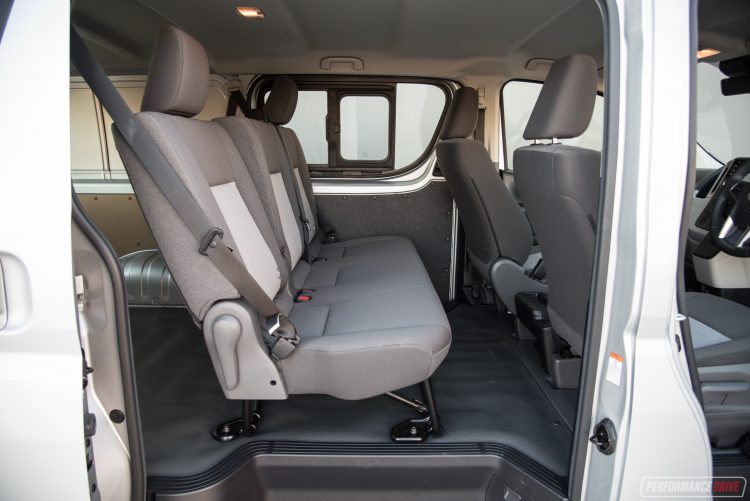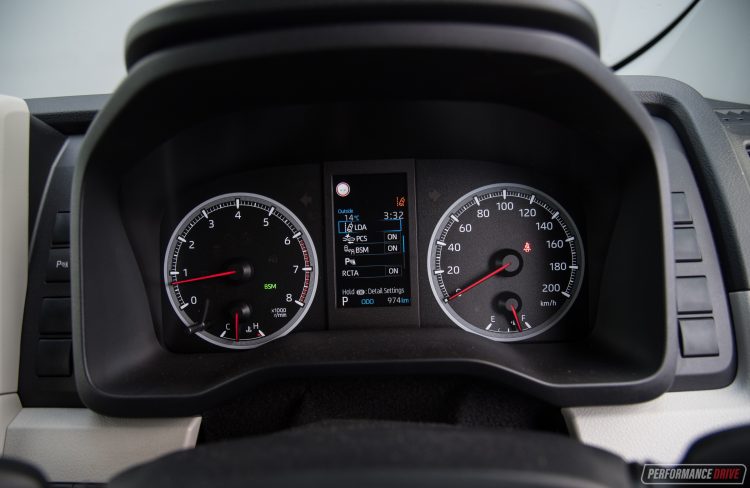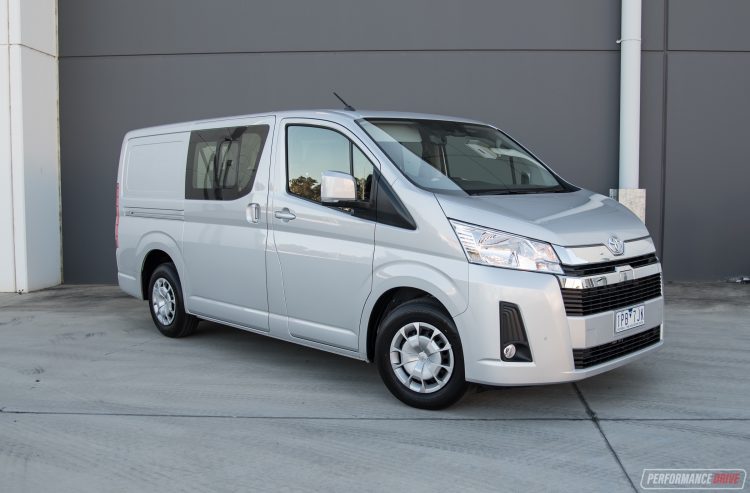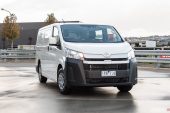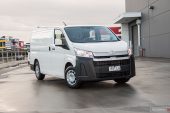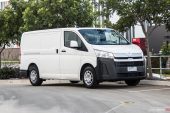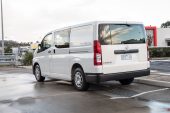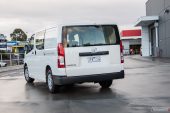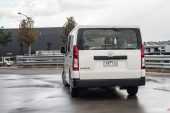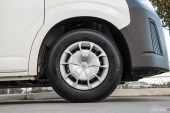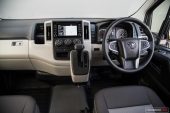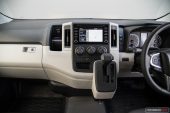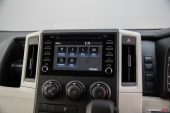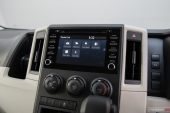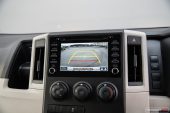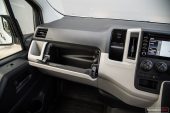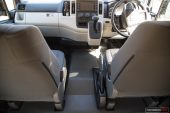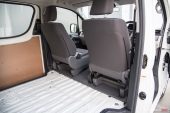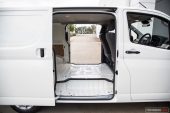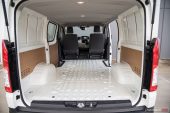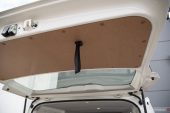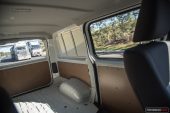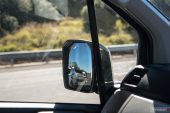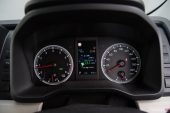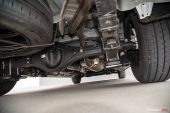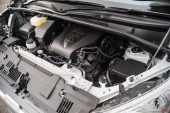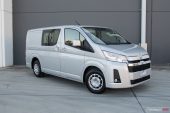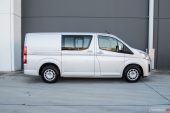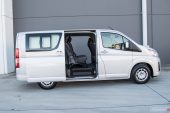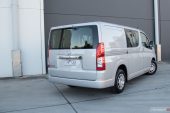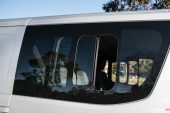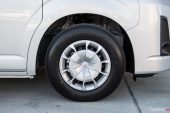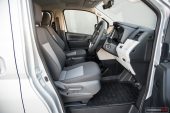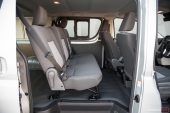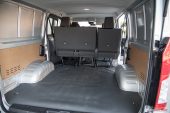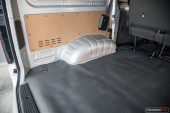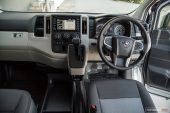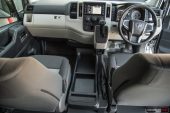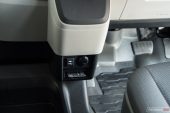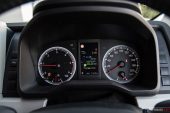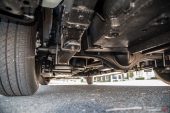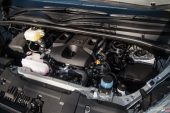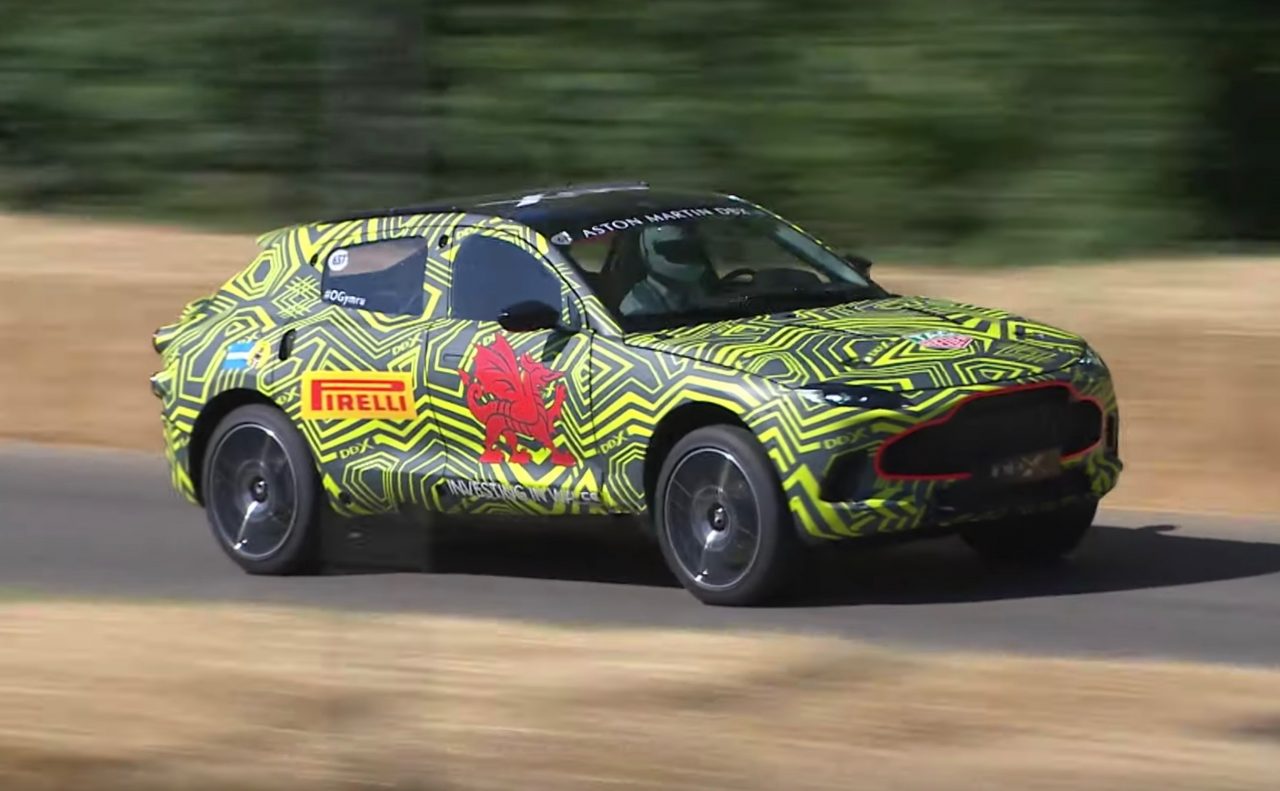It’s the first all-new Toyota HiAce in 15 years, but has it been worth the wait? On paper it certainly seems like it has been worth it as Toyota has thrown everything at this new model, including more power from the engines, vastly improved the safety, and pulled the interior well up to and even past modern standards.
As usual, Toyota offers a multitude of different variants, body styles and sizes of the HiAce. There’s the standard LWB (long wheel base), LWB Crew (second row of seats), the SLWB (super long), and the Commuter bus. There’s also a new 2.8-litre turbo-diesel four-cylinder, borrowed from the HiLux/Prado/Fortuner, as well as, most excitingly, a 3.5-litre petrol V6. Yep, a petrol V6. It’s nuts. But we’ll get to that below.
For this review we’re looking at the base model LWB V6 matched with the optional six-speed auto. We’re also testing the LWB Crew diesel in a couple of weeks, and we’ll include a separate video and additional images for this review once we test it – keep a look out on the YouTube channel.
Prices for the new model start from $38,640 for the V6 manual, and from $40,640 for this auto. The 2.8 diesel is actually $3500 more expensive than the V6, which we find a bit strange. It’s as though Toyota wants you to buy the V6 version.
UPDATE: We have now tested the HiAce Crew with the 2.8-litre turbo-diesel engine option (silver vehicle pictured). It produces 130kW and 450Nm, matched to a six-speed automatic. The engine is identical to the unit found in the HiLux and Prado, offering a combined cycle fuel consumption of 8.4L/100km for this Crew five-seater, or 8.2L/100km for the standard two-seat version.
We were hoping to test the standard two-seat version with the diesel purely for comparison’s sake, especially for our 0-100km/h test. However, no such model was available on the media fleet at the time of booking. It was interesting to sample the versatility of the five-seat Crew nonetheless. See an ‘update’ at the bottom of each section below for our evaluation of the Crew diesel.
2019 Toyota HiAce V6 – THE SPECS
[column width=”47%” padding=”6%”]Engine: 3.5-litre V6 petrol
Output: 207kW@6000rpm / 351Nm@4600rpm
Transmission: Six-speed auto
Drive type: Rear-wheel drive, electronic LSD
Wheels: F & R: 16×7.0, 215/70
ANCAP: Five stars
Tare weight: 2095kg
Power-to-weight: 10.24:1 (kg:kW)
Official fuel economy: 12L/100km
Economy during test: 13L/100km
Fuel capacity/Type: 70L/91 RON[/column] [column width=”47%” padding=”0″]Power efficiency: 17.25kW:L/100km
0-60km/h: 4.03 seconds*
0-100km/h: 8.38 seconds*
60-110km/h: 5.72 seconds*
1/8 mile: 10.85 seconds at 114.2km/h*
1/4 mile: 16.44 seconds at 141.9km/h*
Max acceleration: 0.732g
100-0km/h braking: 3.13 seconds at 40.16 metres*
Max deceleration: -1.148g
Decibel at idle: 49*
Peak decibel at 60-100km/h: 86*
Priced from: $40,640 (manual $38,640)[/column][end_columns]
2019 Toyota HiAce Crew Diesel – THE SPECS
[column width=”47%” padding=”6%”]Engine: 2.8-litre turbo-diesel four-cylinder
Output: 130kW@3400rpm / 450Nm@1600-2400rpm
Transmission: Six-speed auto
Drive type: Rear-wheel drive, electronic LSD
Wheels: F & R: 16×7.0, 215/70
ANCAP: Five stars
Tare weight: 2300kg
Power-to-weight: 17.69:1 (kg:kW)
Official fuel economy: 8.4L/100km
Economy during test: 8.8L/100km
Fuel capacity/Type: 70L/Diesel[/column] [column width=”47%” padding=”0″]Power efficiency: 15.47kW:L/100km
0-60km/h: 4.83 seconds*
0-100km/h: 11.55 seconds*
60-110km/h: 9.22 seconds*
1/8 mile: 11.59 seconds at 100.3km/h*
1/4 mile: 18.08 seconds at 125.0km/h*
Max acceleration: 0.672g
100-0km/h braking: 3.26 seconds at 41.88 metres*
Max deceleration: -1.079g
Decibel at idle: 52*
Peak decibel at 60-100km/h: 82*
Priced from: $47,140[/column][end_columns]
* Figures as tested by PerformanceDrive on the day. Factory claims may be different
2019 Toyota HiAce LWB – THE PACKAGE
The 2019 HiAce is an all-new car. It’s based on platform that’s wider and longer than the predecessor, resulting in 570mm of added overall length. The wheelbase also spans a whopping 640mm further, and the width is increased by 25mm, both of which really help to open up cargo space. What you’re left with is 200L more space in the back, with 6200L, or 6.2 cubic-metres. Overall height is raised by 10mm.
Another key dimension change is the track widths. The front and rear are widened, by 200mm at the front and 205mm at the back. And this not only helps to increase the cargo space load width, but also to improve driving dynamics and stability. The cargo space width is now 1760mm, and 1268mm in between the wheel arches. This means it will easily swallow an Australian standard pallet (1165mm). On the new SLWB versions, the dual sliding doors open 70mm wider, which is enough room for a pallet to be slotted in from the side.
All of this packaging stuff is really good news for buyers in this class, as it means the HiAce is more versatile than ever before. And to coincide with this, the passenger area has also been hugely updated in both design and technology.
Starting with the dash. All models come with a 7.0-inch touch-screen media interface. It’s Toyota’s widely-used screen, but that’s ok as it does package everything a modern driver could need. There’s digital radio, standard sat-nav with SUNA live traffic updates, Bluetooth and USB connectivity, and voice recognition with Siri eyes-free for compatible iPhones. Toyota Australia says Android Auto and Apple CarPlay will also be included as standard from the fourth quarter of this year, and owners will be able to have it retrofit for those who take delivery beforehand.
The screen is practical and easy to use, with some physical main menu buttons around the screen for quicker selections on the go. It also displays the view from the standard rear-view camera, and includes guidance lines.
Seating space is not an issue at all, with a high ceiling giving plenty of clearance, even for tall individuals. The seating position is quite high, and the window sills are low, with a large windscreen providing ample forward visibility. This test car also features a window for the passenger side sliding door, which helps with over-the-shoulder visuals (a steel panel is optional on some variants).
There is still a large blind-spot as usual with vans that have steel panels in place of windows. Fortunately, the new HiAce comes with blind-spot monitoring as standard, with lane-keep assist that can automatically adjust the steering to keep you from wandering outside the lane.
Speaking of safety equipment, Toyota has done a fantastic job in this department. This new van comes with loads of tech, some of which isn’t even standard on some passenger cars and even sub-premium Euro cars. It’s all part of Toyota’s Safety Sense suite, which includes autonomous emergency braking with day and night pedestrian detection, and day cyclist detection, as well as lane departure alert and steering assist as mentioned. There’s also automatic high-beam headlights, road sign recognition, front and rear parking sensors, and rear cross-traffic alert. Impressed yet?
As for the areas that we think could require consideration. We’ve searched around on Toyota’s website and used the build-a-car function, but it seems you can’t option for three seats in the front. The lack of a middle seat isn’t our main issue though. It’s more that there’s a big leftover cavity where a seat could easily go. There’s no centre console either (although, we suspect a console is optional. See Crew cab below). Basically, you’re left with a chunk of wasted space.
And it’s not like you can really store anything here as it will slide around. About the only thing that would fit is a big Esky. Maybe this is Toyota’s intention? There seems to be a lack of smaller storage options around the dash, too. Two cup holders and a glove box is all you get, aside from a little slot near the gear lever that’s too shallow to grasp anything; a wallet or phone falls straight out.
UPDATE: The Crew layout incorporates a three-seat bench in the back, which provides plenty of headroom and legroom. The backrests offer recline adjustment for extra comfort, and this test car also came with a large centre console tray in the front which can be accessed from the rear seat. Both sliding doors also feature windows that include little opening sections, and instead of a bare metal floor (painted) the Crew comes with a vinyl sheet. During our test we removed the middle seat headrest as it obstructs the rear view quite a bit.
Cargo space is obviously reduced in comparison to the standard cab, but the load width of 1760mm and width between the wheel arches, rated at 1268mm, remains the same. All in all, the Crew is the perfect option for those who need the heavy-duty load-hauling capability of a van, but require more than two seats. It’s worth noting that you can technically remove the rear seats if needed, however, the floor does feature the vinyl sheet which isn’t quite as robust as the metal floor in the standard two-seat version.
On the outside the Crew showcases body-coloured bumper bars and a chrome trim piece for the tailgate. Aside from that, it looks pretty much the same, including using the same wheels/hubcaps. We’ve updated the photo gallery below to include images of the Crew diesel – we’ve placed the images in the second half of the gallery (look for the silver vehicle).
2019 Toyota HiAce LWB – THE DRIVE
You probably think we’ve lost our marbles by saying this, but this is actually a lot of fun to drive. The perched up seating position gives you a commanding view of the road ahead, and the front wheels are now placed right at your feet. This makes it extremely easy to place on the road, and especially simple to navigate in tight car parks and loading docks and so on. Toyota has used a hydraulic rack and pinion steering system on all variants, so there’s plenty of feel and precision.
Ride comfort is also improved over the predecessor thanks to a new independent front suspension setup and live axle rear end with leaf springs. Toyota says the leaf springs offer an increased span, with different rates for the LWB and SLWB to suit specific loads of each. The dampers are also placed on the outer sides of the leaf springs, instead of on the inner sides, which Toyota says improves stability and ride comfort.
In our opinion, the ride and handling of the new HiAce is impressive. But we must admit, we didn’t load up the rear with heavy items to test what it’s like under load. Sitting over the MacPherson struts at the front means there is plenty of give over big bumps, and while leaf springs are old hat, passengers are unaffected due to positioning.
So, how about that V6 engine? We’ve experienced this engine plenty of times before, as it’s essentially the same 2GR unit you’ll find in the Toyota Kluger and Camry V6, albeit retuned slightly. It’s smooth and refined, and features direct and port injection (D-4S), with double overhead cams, dual VVT-i (variable valve timing), and all running a high 11.8:1 compression ratio. The unit produces 207kW at 6000rpm, and 351Nm at 4600Nm.
These are some decent figures on their own, but in a van like this, they are hilarious – Toyota does have a sense of humour after all? In fact, this engine makes the new HiAce the most powerful van in the class. The engine requires only 91 RON fuel and it does meet Euro 5 emissions standards. However, the official combined cycle fuel consumption is an eyebrow-raising 12L/100km. We averaged around 13 during our week. So although it is very powerful, you will need to pay for it. Regularly.
Out on the road we were expected to constantly battle single wheel wheelspin. But Toyota is on top of this and has fitted what it calls an Auto-LSD to all variants. It’s essentially a brake-type limited-slip diff. During our test it worked just like a conventional mechanical LSD. You can pretty much floor the throttle around a tight hairpin and it will not spin away all the power. It actually hooks up and provides surprisingly stable and confident power delivery to the road. Even in the wet.
In terms of straight-line acceleration, we clocked a best 0-100km/h time of 8.38 seconds. This is definitely fast enough for a car of this type. It’s actually fun to accelerate away from the lights and leave other motorists behind. In that sense, it is a bit of a sleeper. Our only gripe is this engine requires lots of revs to reach its potential. And in a commercial van, revving engines can seem a bit brash. That peak torque figure of 351Nm, which is not particularly high, isn’t available until 4600rpm.
As mentioned we will be sampling the turbo-diesel version in a couple of weeks and we’ll update this section of the review with some comments on that. But on paper the diesel does seem like the more logical choice. The diesel produces 130kW at 3400rpm, and 420Nm between 1400-2600rpm for the manual. Going for the auto gets you an impressive 450Nm, available between 1600-2400rpm. It will be interesting to see the 0-100km/h time of this engine. Stay tuned.
UPDATE: The 2.8-litre turbo-diesel is a smooth and refined engine in the world of commercial vehicles. But not only that, it’s pretty refined for a passenger car, too. We must remember this is the same engine that’s featured in the top-spec Prado and Fortuner. That typical diesel clatter is reduced to a minimum, especially at cruising speeds. Power delivery is also very linear, aside from a very minor initial lag as the drivetrain takes up the slack.
Overall, we really like the diesel. With 450Nm of torque available between 1600rpm and 2400rpm, the low-end pickup is surprisingly brisk. Okay, so it doesn’t offer the sheer top end grunt of the V6 petrol, but in the real world, where you’re spending a lot of time going from 0-60km/h, or 20-80km/h, this engine performs just fine. It also comes with the ‘Auto LSD’ for the rear axle so there are no traction issues at all, which really helps when getting out of those tight and awkward driveways.
As mentioned, we were hoping to test the standard non-Crew two-seater with the diesel, purely for comparison in the 0-100km/h test. However, such a model wasn’t available. After checking the specs, the Crew diesel is 80kg heavier than the standard two-seat diesel, so we’d expect a very marginal difference in performance. We also notice the Crew diesel auto is 185kg heavier than the V6 auto two-seater (as tested).
2019 Toyota HiAce – THE VIDEOS
2019 Toyota HiAce LWB – THE VERDICT
Yes it looks a bit weird, on first impressions, and yes V6 power is probably not needed for most buyers. But, the 2019 Toyota HiAce makes some huge leaps forward in a number of important areas. As a result, it’s undoubtedly the best HiAce yet, and now it at least meets or forges new benchmarks in this segment.
While we wouldn’t categorically recommend the new V6 over the 2.8 turbo-diesel, it is a refreshing engine for the segment as most competitors are offered with boring eco-focused petrol or diesels. And if you place performance and swiftness at the top of your priorities, the V6 is obviously the one you should go for – it is the quickest van in the class. And in that respect, it is our new favourite van.
UPDATE: Having testing the diesel, we think it is the more suitable engine for this application. Sure, the V6 is a bag of fun and it sounds the goods. But for everyday driving, including frequent stop-start conditions in the city and suburbs, the diesel will no doubt provide superior fuel economy. During our week we averaged around 8.8L/100km, with the same 70L tank providing a real-world range of around 700km (well before the fuel light warning).
[column width=”47%” padding=”6%”]PROS:
– Comprehensive touch-screen for all variants; digital radio, sat-nav
– Very impressive standard safety tech; AEB, road sign reading, rear-view camera
– V6 option is the most powerful engine in the class
– Surprisingly good handling and fun to drive, standard LSD
– Huge cargo area
– Smooth and quiet 2.8 diesel
[/column] [column width=”47%” padding=”0″]CONS:
– V6 fuel consumption
– V6 requires revs, diesel option offers more torque
– Lacks some storage around the dash and console area
– 2.8 diesel lacks top-end grunt (80-110km/h, for example)[/column][end_columns]
As always, if you’re thinking about buying a new car don’t forget to click here to speak with our car buying specialists.
